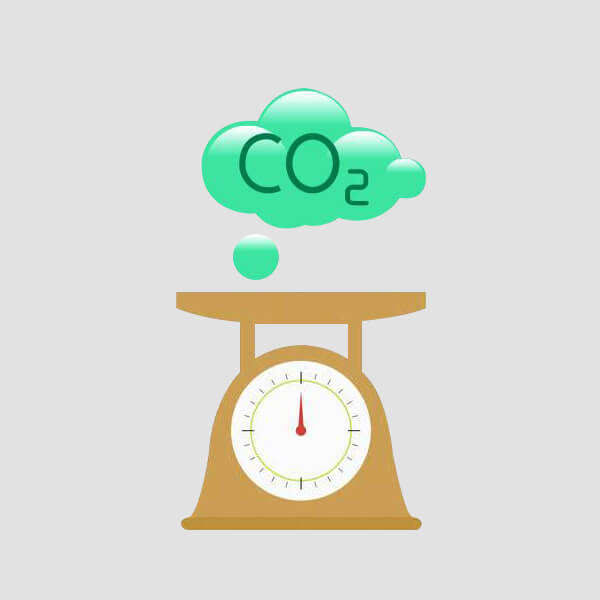Carbon dioxide is a gaseous compound produced by the reaction of carbon and oxygen. Its chemical formula is CO2. A carbon dioxide molecule consists of two oxygen atoms and one carbon atom. Carbon dioxide is an inorganic substance that is not flammable and generally does not support combustion. It is non-toxic at low concentrations, but when the concentration of carbon dioxide in the environment exceeds a certain amount, carbon dioxide will have an impact on the human body. This article explains in detail how to measure carbon dioxide?
Why measure Carbon Dioxide?
As we said, carbon dioxide at room temperature is a colorless, odorless gas that cannot be detected by the senses. Low concentrations of carbon dioxide are not toxic, while high concentrations of carbon dioxide can poison animals. Also, carbon dioxide is very harmful to the environment and it is the main cause of the greenhouse effect.
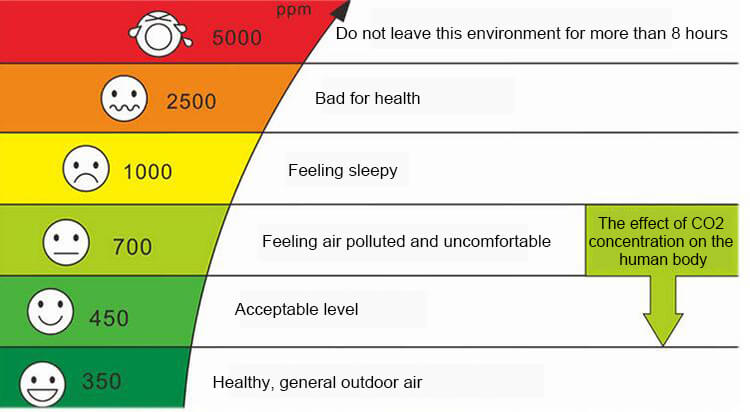
Greenhouse gases such as carbon dioxide in the atmosphere can radiate long-wave radiation with longer wavelengths to the ground after absorbing the long-wave radiation on the ground, which has a thermal insulation effect on the ground. When the temperature continues to increase, it leads to global warming. In addition, human activities will emit a large amount of carbon dioxide, resulting in a sharp increase in the concentration of greenhouse gases in the atmosphere, resulting in an increasing greenhouse effect. By measuring the amount of carbon dioxide (CO2) in the environment, timely action and preventive measures can be taken to reduce the concentration of carbon dioxide in the atmosphere.
In agriculture, carbon dioxide is one of the raw materials for green plants to carry out photosynthesis, and 95% of the dry weight of crops comes from photosynthesis. Therefore, the use of carbon dioxide sensors to control the concentration has become an important factor affecting crop yield. For example, in greenhouse planting, the level of carbon dioxide concentration will affect the growth quality of crops.
Industrially, solid carbon dioxide is commonly used to refrigerate frozen foods and other perishable foods in transit, and as a refrigerant in many industrial processes. Gaseous carbon dioxide is commonly used in carbonated beverages, pH control in water treatment processes. In the medical industry, it is also used as a diluent for bactericidal gas. Achieving this all requires need to measure carbon dioxide (CO2).
How is Carbon Dioxide (CO2) measured?
Carbon dioxide sensors are the most commonly used tools to measure carbon dioxide (CO2) concentrations. The carbon dioxide concentration is detected by the measuring unit and converted into a digital display to the user. There are three main types of carbon dioxide (CO2) sensors: electrochemical sensors, non-dispersive infrared (NDIR) sensors, and metal oxide semiconductor (MOS) sensors.
Electrochemical gas sensor is a detector that allows gas to be oxidized or reduced at the electrode to measure the current and obtain the gas concentration. When the gas diffuses into the working electrode of the sensor, the gas is oxidized or reduced, and this electrochemical reaction generates a current flowing through the external circuit, and the gas concentration is converted by measuring the current value. In addition to measurement, amplification and other signal processing are performed, and the external circuit maintains the voltage across the sensor and the voltage of a two-electrode back-referenced sensor. An opposite reaction occurs at the counter electrode. Thus, if the working electrode is oxidizing, the opposite electrode is reducing.
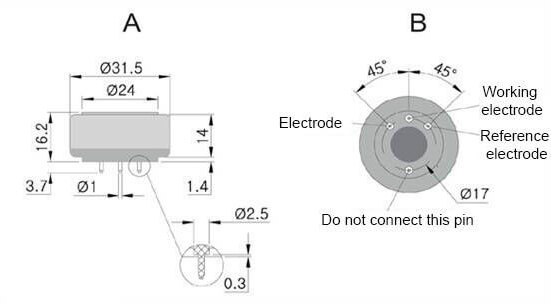
The magnitude of the current depends on how much carbon dioxide is oxidized at the electrodes. The sensor is designed so that the gas supply is diffusion limited and the sensor has a linear output proportional to the gas concentration. Linear output is one of the advantages of electrochemical sensors over other technology sensors.
Pros
Electrochemical sensors are generally less vulnerable to humidity and temperature changes.
Non-Dispersive Infrared (NDIR) Sensors
Different elements on Earth absorb certain types of light. For example: green reflects green light but absorbs light of other colors. Our eyes cannot see this process. When elements are broken down into atoms and molecules, we can know exactly what kind of light they each absorb, even light that our eyes can’t see. That’s how NDIR sensors work! The principle of non-divergent infrared gas sensors is that various gases absorb light. And different gases absorb light of different wavelengths, such as CO2 is most sensitive to infrared (wavelength of 4.26 m).
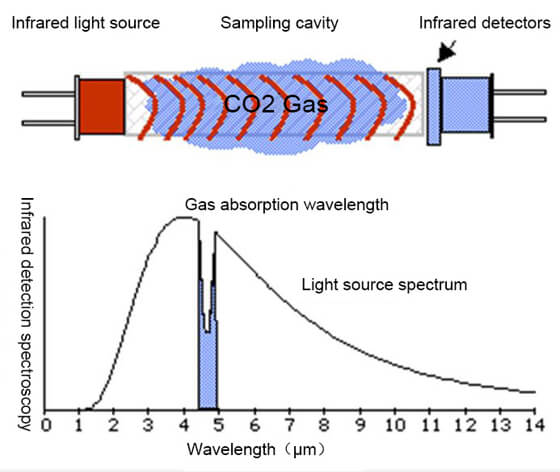
The light passes through the carbon dioxide gas in the optical path, passes through the filter, and reaches the infrared detector. The concentration of carbon dioxide (CO2) is determined by measuring the intensity of infrared light from the infrared sensor. When there is no carbon dioxide (CO2) in the environment, its intensity is the strongest. When carbon dioxide (CO2) enters the gas chamber, carbon dioxide absorbs part of the infrared light, so that the light intensity reaching the detector is weakened. The concentration of carbon dioxide can be calculated.
Pros
NDIR sensors have a long service life and a wide measurement range.
Metal Oxide Semiconductor (MOS) Sensors
The sensitive source of metal oxide semiconductor gas sensor is mainly made of semiconductor material. The most widely used semiconductor material is not the common silicon and germanium semiconductor, but metal oxide semiconductor. The basic working principle of metal oxide semiconductor gas sensor: under certain conditions (temperature), after carbon dioxide (CO2) in the air contacts with metal oxide semiconductor material, the chemical composition will be changed through reduction or oxidation reaction, and the process will be accompanied by electric charge. The transfer further causes the change of the resistance of the semiconductor, and the detection of the gas can be realized by measuring the change of the resistance of the semiconductor.
Pros
They are relatively easy to use due to their simple design.
Recommended CO2 Sensors
This wall mounted CO2 sensor is an NDIR CO2 sensor. It’s a universal wall-mounted sensor with built-in temperature and humidity sensors! It has high protection and various functions, can measure carbon dioxide with accuracy. Its built-in temperature sensor is also equipped with temperature compensation to ensure accurate temperature measurement.
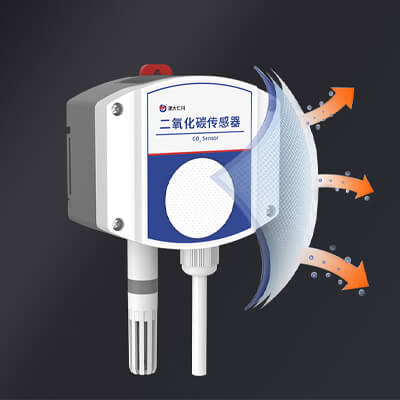
The waterproof and breathable membrane on the surface can only allow gas to pass through, effectively blocking the erosion of the sensor by moisture in the environment. It can be used in a high concentration carbon dioxide (CO2) environment above 800ppm for a long time. It has RS485 and analog output methods. If you choose rs485 signal output, you can use a host to collect data from multiple areas and upload them to the cloud platform. Realize remote monitoring and data viewing. If you choose analog output, you can use your own PLC or other data acquisition equipment to realize data viewing.
Wall-mounted temperature and humidity carbon dioxide sensor
RS-CO2*-*-2 carbon dioxide sensor is a 3-in-1 sensor, the temperature and humidity probe at the bottom can detect the temperature and humidity in the environment, and the built-in carbon dioxide sensor can measure carbon dioxide concentration. A variety of factors can be measured by one device to meet the needs of users. It has a wide measurement range, the most commonly used are 0-5000ppm and 0-10000ppm, other ranges can be customized. It is a cost-effective industrial gas sensor.
Sometimes, due to various requirements, we do not only measure the carbon dioxide (CO2) concentration in one location, we may need to measure carbon dioxide in different places, such as: mine or tunnel workers, each time before entering a closed environment, need to measure carbon dioxide concentration inside, a gas sensor that can move freely and directly display the measured value is particularly important.
This sensor contains many functions! It has a dust-proof industrial design for harsh outdoor conditions. Equipped with an NDIR CO2 sensor and rechargeable battery, this portable CO2 sensor can directly measure and display the current ambient carbon dioxide concentration. It’s the same size as the phone we use, making it easy to carry. You can also manually set the alarm value, it is a professional wireless carbon dioxide measurement device.
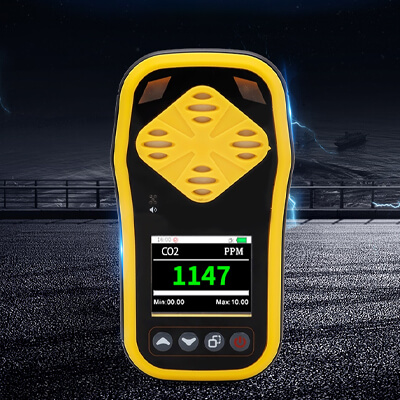
Handheld carbon dioxide sensors are used in laboratories, greenhouses and mushroom houses, etc. Different options, measuring range from ppm to percent.
The online carbon dioxide sensor is suitable for real-time detection of carbon dioxide concentration and leakage in industrial environments. It adopts high-precision infrared NDIR sensor and microcontroller technology. It has fast response speed and high measurement accuracy.
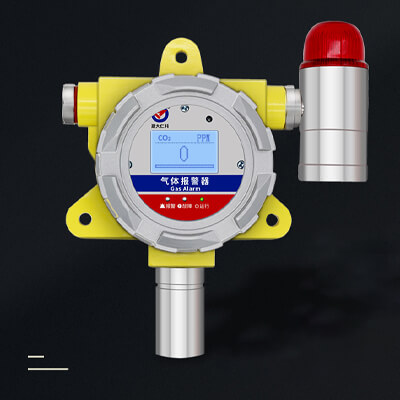
Its explosion-proof wiring method is suitable for various dangerous places, and is compatible with various control alarms, PLC, DCS and other control systems. It can simultaneously realize on-site alarms. Perfect display of various technical indicators and gas concentration values. At the same time, it has a variety of strong circuit protection functions, which can effectively prevent the damage of the instrument caused by various human factors and uncontrollable factors.
This carbon dioxide sensor is widely used in many industries, especially in flammable and explosive places, and it is also of great significance for the detection of toxic and harmful gas places.
Car carbon dioxide sensor
This carbon dioxide gas sensor is a general-purpose smart small sensor that uses the principle of non-dispersive infrared (NDIR) to detect CO2 in the air. It has the characteristics of good selectivity, no oxygen dependence, and long life. Built-in temperature compensation. At the same time, it has serial output, analog output and PWM output, which is convenient to use.
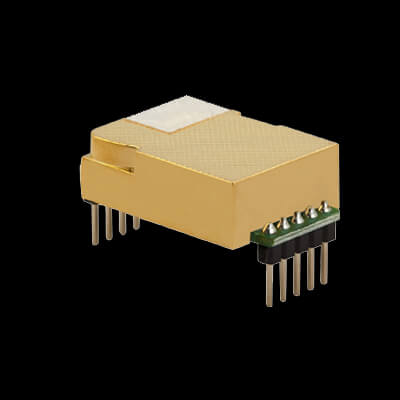
The sensor is a high-performance sensor made by closely combining mature infrared absorption gas detection technology with precise optical path design and sophisticated circuit design.
It has good selectivity and no oxygen dependence, and is widely used in automobiles, buses, smart home appliances and other fields.
Applications of CO2 sensors
1. Application in aquaculture industry
Some large-scale farms, such as cattle, pig, chicken factories, etc., are in some closed or semi-closed environments. Because of their large numbers, these livestock exhale large amounts of carbon dioxide. If not ventilated in time, high concentrations of carbon dioxide will cause problems such as hypoxia, anorexia, and slow growth in animals. At the same time, lack of air movement can easily lead to weakened immunity and disease outbreaks in livestock.
Install carbon dioxide sensors on the farm to monitor the concentration of carbon dioxide. When the concentration of carbon dioxide in the farm reaches a certain amount, the exhaust system can be activated to replace fresh air and provide a good breeding environment for the growth of livestock.
2. Application of industrial waste gas
There are many types of industrial waste gas, which may cause different harm to the environment. Exhaust gas refers to the toxic and harmful gases emitted by human production and life. Especially chemical plants, steel plants, pharmaceutical plants, oil refineries, etc., as well as the production of domestic waste gas brought by human life. The smell of exhaust gas is very strong, which seriously pollutes the environment and affects human health.
As economies develop, human activities, such as burning fossil fuels and deforestation, contribute to increasing concentrations of greenhouse gases. There are also some industrial enterprises that generate a large amount of CO2 gas and discharge it from the opening of the pipeline. These make global warming one of the greatest challenges facing humanity today.
The greenhouse effect is quietly affecting people’s living environment, such as rising sea level, abnormal climate, increasing desertification area and so on. Therefore, it is necessary to monitor the concentration of flue gas when discharging industrial waste gas. A carbon dioxide sensor that measures the concentration of carbon dioxide can be installed in the chimney to strictly control the concentration of carbon dioxide in the exhaust gas.
3. Application of indoor HVAC
If there are many people in the room and the air is not ventilated, coupled with the CO2 emitted by the human body, the oxygen content in the air is relatively reduced, and the carbon dioxide concentration is increased, and the indoor people will have different degrees of poisoning symptoms.
Many people who often stay indoors like to turn on the air conditioner for ventilation, but the air purification effect of ordinary central air conditioners is poor, resulting in a lot of indoor air pollutants. Among them, gaseous pollutants are carcinogenic to the human body, and microorganisms are easy to cause various allergic diseases. Although the purification effect of the environmental protection air conditioner cannot be compared with that of the air purifier, but air passing through the environmental protection air conditioner is also odorless and fresh, so the indoor CO2 concentration will be reduced.
4. Application of agricultural greenhouse
All kinds of vegetables in agricultural greenhouses need to absorb carbon dioxide for photosynthesis. However, crops in greenhouses are kept in relatively closed places for a long time, and the carbon dioxide concentration inside them varies greatly within a day. Therefore, the shortage of carbon dioxide in the greenhouse is quite serious, which has become an important factor affecting the yield of greenhouse vegetables. The use of carbon dioxide sensors to control the concentration has also become an important factor affecting the crop yield. At present, many greenhouses have begun to use carbon dioxide sensor environmental monitoring equipment. The installation of carbon dioxide sensors in agricultural greenhouses can ensure timely alarm when the carbon dioxide concentration is insufficient, so as to use gas fertilizers. Ensure healthy growth of vegetables, flowers, etc.
Summary
Measure carbon dioxide is not difficult. Just choose a good carbon dioxide sensor. At present, NDIR is the most widely used one. This article introduces you in detail where need to measure carbon dioxide. If you have other questions about measuring carbon dioxide, please to contact us.

